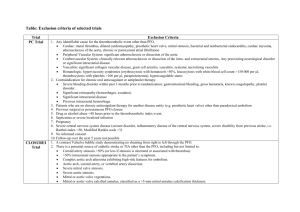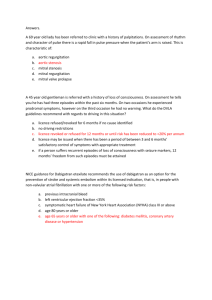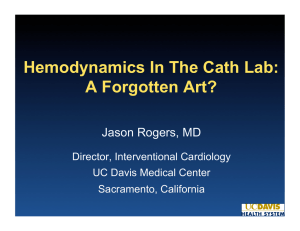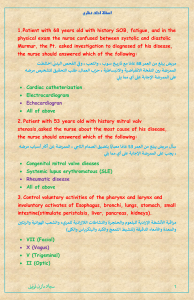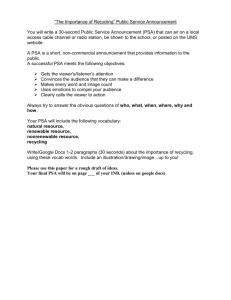MATH 3900, Spring 2009 Homework 2 Due 02/06/09 at 8am
advertisement
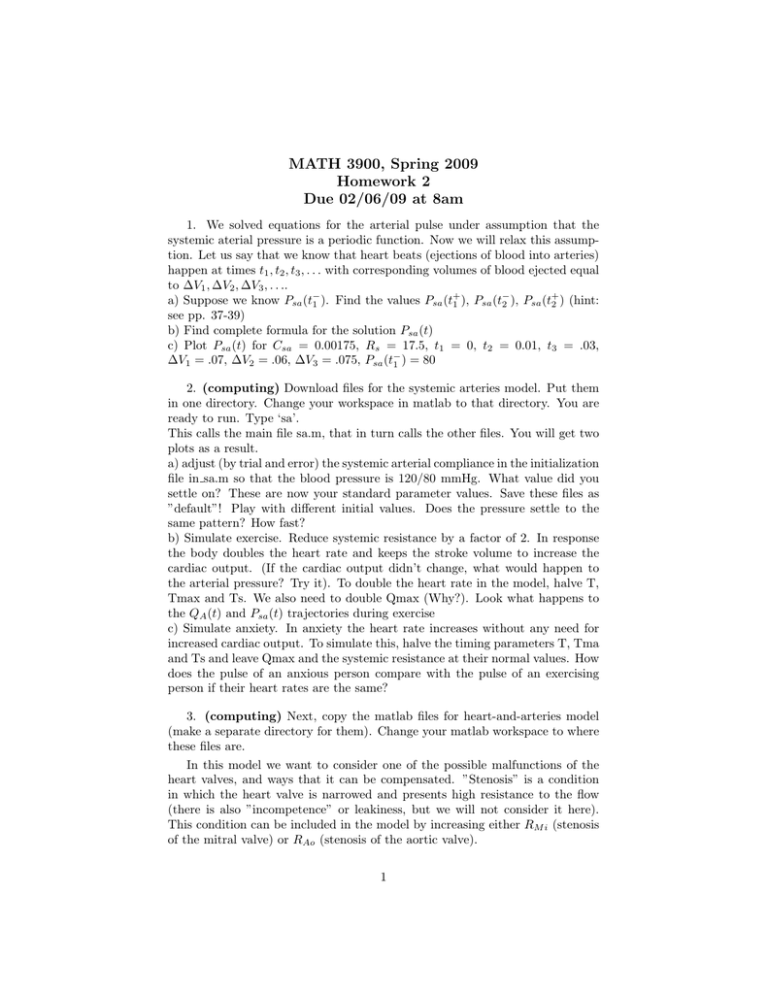
MATH 3900, Spring 2009 Homework 2 Due 02/06/09 at 8am 1. We solved equations for the arterial pulse under assumption that the systemic aterial pressure is a periodic function. Now we will relax this assumption. Let us say that we know that heart beats (ejections of blood into arteries) happen at times t1 , t2 , t3 , . . . with corresponding volumes of blood ejected equal to ∆V1 , ∆V2 , ∆V3 , . . .. + − + a) Suppose we know Psa (t− 1 ). Find the values Psa (t1 ), Psa (t2 ), Psa (t2 ) (hint: see pp. 37-39) b) Find complete formula for the solution Psa (t) c) Plot Psa (t) for Csa = 0.00175, Rs = 17.5, t1 = 0, t2 = 0.01, t3 = .03, ∆V1 = .07, ∆V2 = .06, ∆V3 = .075, Psa (t− 1 ) = 80 2. (computing) Download files for the systemic arteries model. Put them in one directory. Change your workspace in matlab to that directory. You are ready to run. Type ‘sa’. This calls the main file sa.m, that in turn calls the other files. You will get two plots as a result. a) adjust (by trial and error) the systemic arterial compliance in the initialization file in sa.m so that the blood pressure is 120/80 mmHg. What value did you settle on? These are now your standard parameter values. Save these files as ”default”! Play with different initial values. Does the pressure settle to the same pattern? How fast? b) Simulate exercise. Reduce systemic resistance by a factor of 2. In response the body doubles the heart rate and keeps the stroke volume to increase the cardiac output. (If the cardiac output didn’t change, what would happen to the arterial pressure? Try it). To double the heart rate in the model, halve T, Tmax and Ts. We also need to double Qmax (Why?). Look what happens to the QA (t) and Psa (t) trajectories during exercise c) Simulate anxiety. In anxiety the heart rate increases without any need for increased cardiac output. To simulate this, halve the timing parameters T, Tma and Ts and leave Qmax and the systemic resistance at their normal values. How does the pulse of an anxious person compare with the pulse of an exercising person if their heart rates are the same? 3. (computing) Next, copy the matlab files for heart-and-arteries model (make a separate directory for them). Change your matlab workspace to where these files are. In this model we want to consider one of the possible malfunctions of the heart valves, and ways that it can be compensated. ”Stenosis” is a condition in which the heart valve is narrowed and presents high resistance to the flow (there is also ”incompetence” or leakiness, but we will not consider it here). This condition can be included in the model by increasing either RM i (stenosis of the mitral valve) or RAo (stenosis of the aortic valve). 1 a) Simulate either condition over a range of resistances and discuss their effect on the stroke volume, left ventricular blood pressure and systemic arterial blood pressure. Illustrate your observations with graphs b) In reality, the circulatory system can, to a certain extent, compensate for the valve malfunction. In the complete model of circulation the compensatory mechanisms are automatically engaged, as part of the system. In our current partial model we will include them by hand. In mitral stenosis, left atrial pressure rises to maintain stroke volume. Do a simulation of mitral stenosis (as you did in part a), then see how much left atrial pressure needs to increase to bring the stroke volume to normal. Plot the compensatory left atrial pressure as a function of valve resistance. Notice that left atrial pressure should not increase beyond 28 mmHg, as left atrial pressure is similar to the pulmonary venous pressure and this would force fluids into the lungs (pulmonary edema). So what is the most severe mitral stenosis that can be tolerated? c) (extra credit) Do one of the following: - repeat previous exercise (compensation of mitral stenosis) under exercise conditions (this is an interesting case, because patients with mitral stenosis may be asymptomatic at rest and get pulmonary edema when they try to exercise) - do an exercise on aortic stenosis compensation, described on p. 66. 2

